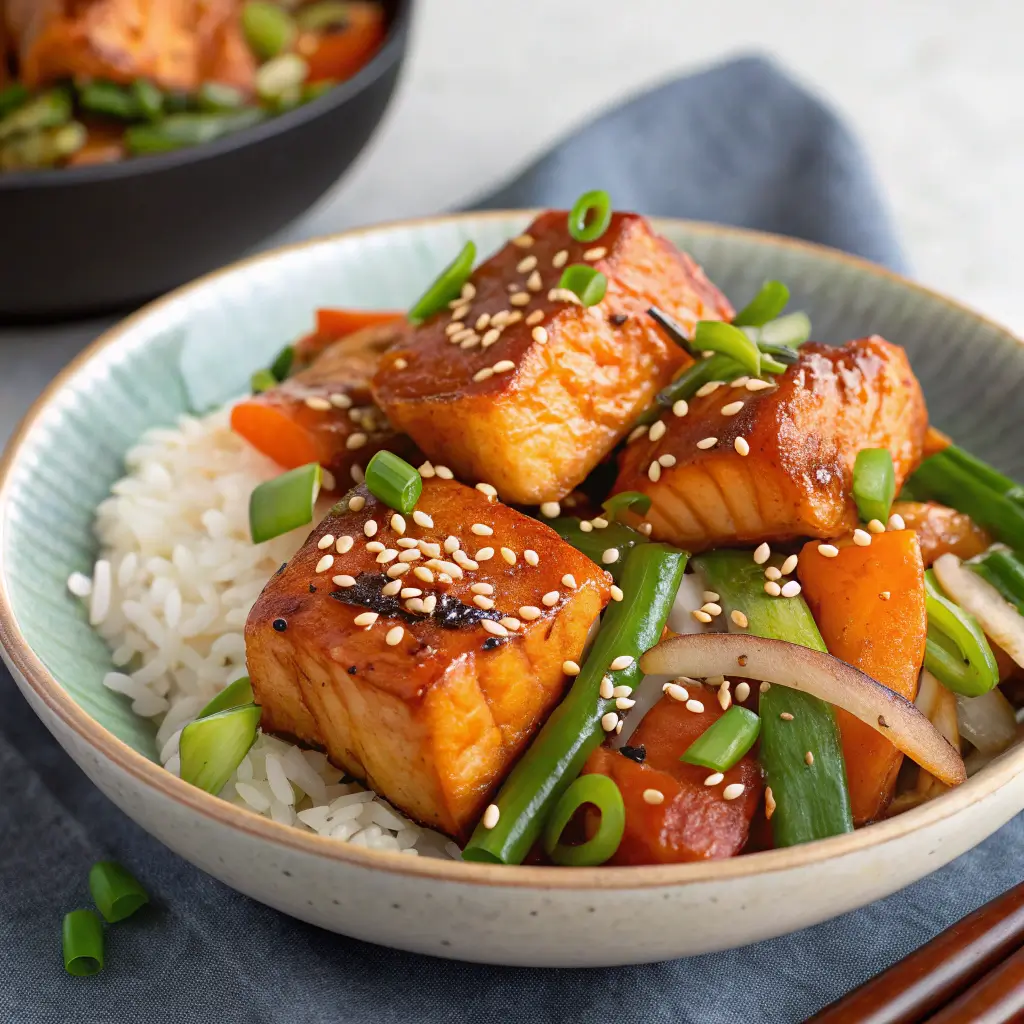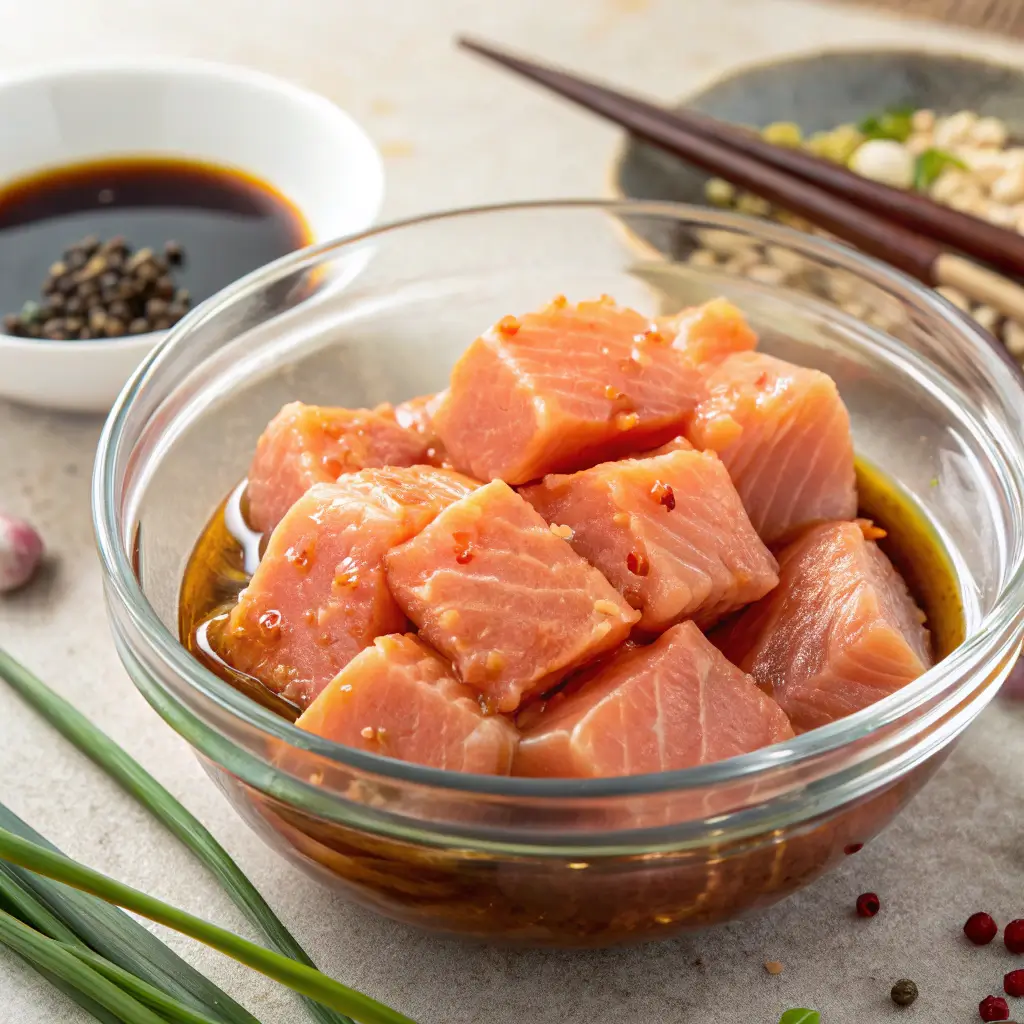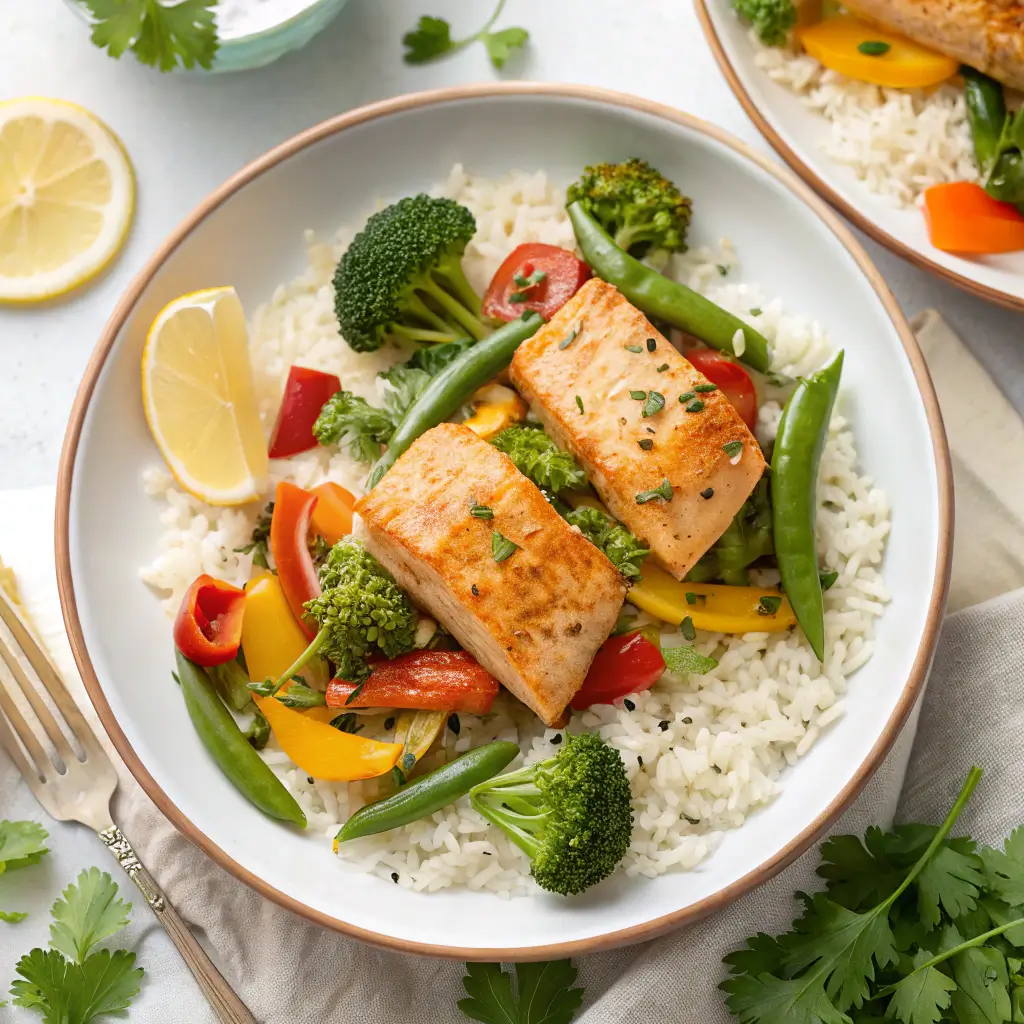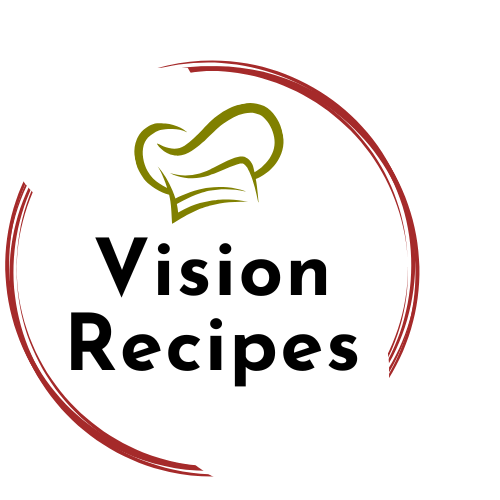
When it comes to quick, flavorful, and healthy meals, salmon recipe bites shine as an unbeatable choice. These bite-sized delights are not only versatile but also packed with nutrients, making them a favorite for busy home cooks and gourmet enthusiasts alike. Whether you’re planning a family dinner, a meal prep session, or a casual gathering, salmon recipe bites can effortlessly steal the show.
In this article, we’ll guide you through everything you need to know to master this dish. From choosing the right salmon and creating a flavorful marinade to searing techniques and serving suggestions, each step is designed to ensure your success in the kitchen. By the end, you’ll be equipped with tips, tricks, and creative ideas to make your salmon recipe bites the star of the table.
Love classic recipes like this? Follow us on Facebook for more comfort food, cookie inspiration, and baking tips shared weekly!
Table of Contents
Introduction to Salmon Recipe Bites
What Are Salmon Recipe Bites?
Salmon recipe bites are small, perfectly cubed pieces of salmon, marinated, and cooked to crispy, golden perfection. These bite-sized portions are not only visually appealing but also deliver a burst of flavor in every bite. They’re versatile enough to be served as an appetizer, a main course, or even tossed into salads and bowls.
Unlike traditional salmon fillets, bites cook faster and absorb marinades more thoroughly, making them a convenient option for quick meals. Plus, their smaller size makes portioning and serving a breeze.
Why Choose Salmon for Quick Meals?
Salmon is a powerhouse of nutrients, offering high-quality protein, omega-3 fatty acids, and essential vitamins like B12 and D. It’s also incredibly versatile, pairing well with a variety of marinades, spices, and side dishes. With salmon recipe bites, you get all these benefits in a format that’s easy to cook and customize.
For those juggling busy schedules, salmon’s quick cooking time is a game-changer. In just a few minutes, you can transform raw salmon into a crispy, flavorful dish that satisfies both the taste buds and nutritional needs.
Benefits of Cooking Bite-Sized Pieces
Cooking salmon in bite-sized portions has several advantages. For one, the smaller surface area allows marinades to penetrate the fish more effectively, ensuring even seasoning and enhanced taste. These smaller pieces also cook more evenly, reducing the risk of overcooking or undercooking.
Moreover, bite-sized pieces are perfect for creative presentations. You can skewer them for a fun twist, serve them over rice, or toss them into a vibrant salad. With salmon recipe bites, the possibilities are endless!
Stay tuned for Part 2, where we’ll dive into the essential ingredients you need to create the perfect salmon bites.
Essential Ingredients for Perfect Salmon Bites
Essential Ingredients for Perfect Salmon Bites
When preparing salmon recipe bites, the choice of salmon can significantly affect the flavor and texture of your dish. Wild salmon often has a stronger, richer taste and is packed with nutrients like omega-3 fatty acids. On the other hand, farmed salmon tends to have a milder flavor and a more tender texture, which some people prefer.
If you’re on a budget, consider buying frozen salmon or smaller cuts, as these work well for cubing. Remember, since the salmon will be marinated and cooked in bite-sized pieces, even less expensive cuts can taste incredible with the right preparation.

Flavorful Marinades: Honey, Soy Sauce, and More
The secret to delicious salmon recipe bites lies in the marinade. A simple blend of soy sauce, toasted sesame oil, and honey creates a balance of salty, sweet, and savory flavors. This trio forms the backbone of most recipes and pairs perfectly with the natural richness of salmon. For added depth, a dash of sriracha can bring some heat.
To cater to different dietary needs, substitutions are easy to make. For example, coconut aminos can replace soy sauce for a gluten-free option, while maple syrup or brown sugar can substitute for honey.
Alternative Sweeteners and Oils
While honey and toasted sesame oil are classics, feel free to experiment. Brown sugar, agave nectar, or molasses can offer a deeper sweetness. For oil, neutral-tasting options like avocado oil or grapeseed oil work well if sesame oil is unavailable. These ingredients are versatile, ensuring your salmon recipe bites taste delicious, no matter your pantry’s contents.
Step-by-Step Cooking Instructions
Preparing and Cubing the Salmon
To start, ensure your salmon is fresh or thoroughly defrosted if frozen. Remove any skin (if desired) and cut the fish into even, bite-sized cubes. Uniformity is key here—it ensures all the pieces cook at the same rate. Pat the cubes dry with a paper towel; this helps the marinade stick better.
Place the salmon cubes into a shallow bowl or dish. This preparation step sets the stage for your perfectly cooked salmon recipe bites.
Marinating: Why It’s Optional But Worth It
While marinating is optional, it adds a significant flavor boost. A quick 30-minute soak in your honey-soy marinade can infuse the salmon with sweetness and umami. If you’re short on time, you can skip this step, but for the best results, let the salmon rest in the fridge for up to six hours, occasionally stirring to ensure even coating.
This process not only enhances the flavor but also tenderizes the fish, making your salmon recipe bites irresistibly juicy.
Perfect Searing Techniques for Crispiness
A hot skillet is essential for perfectly seared salmon. Start by heating a nonstick or cast-iron skillet over medium-high heat. Add a touch of neutral oil to prevent sticking and enhance the crispiness.
Using tongs, place the salmon pieces in the pan, ensuring they are in a single layer. Sear each side for 2–3 minutes until golden brown and cooked through. The key is to resist the urge to overcrowd the pan—this ensures each piece develops a flavorful crust.
Adding Vegetables for a One-Pan Meal
To make this dish even more versatile, cook your favorite vegetables in the same skillet after searing the salmon. Bell peppers, snap peas, or broccoli are excellent choices. The leftover marinade and pan drippings will flavor the vegetables, creating a cohesive, mouthwatering meal.
In just a few simple steps, you’ll have a flavorful, wholesome plate of salmon recipe bites ready to enjoy!
Based on the sitemap review, no directly relevant internal links were found. However, I will add a suggestion for readers to explore more recipes on the website. Below are the written sections:
Serving Suggestions for Salmon Recipe Bites
Rice Pairings: Basmati and Beyond
To complement the rich flavors of your salmon recipe bites, rice is a classic pairing that works beautifully. Basmati rice, with its light and fluffy texture, is an excellent choice. Its neutral flavor balances the boldness of the salmon and marinade. For a healthier alternative, consider brown rice or quinoa, which add a nutty undertone to the meal.

For an extra burst of flavor, you can cook the rice in chicken or vegetable broth. Adding a pinch of turmeric or a splash of lime juice can also enhance the dish.
Creative Vegetable Combinations
Vegetables are the perfect addition to any salmon recipe bites dish, offering a vibrant mix of colors and nutrients. Broccoli, snap peas, and bell peppers pair well with the savory sweetness of the salmon. These veggies can be sautéed in the same pan, absorbing the leftover marinade and intensifying their flavor.
For an added twist, consider roasting sweet potatoes or Brussels sprouts as a side. Their caramelized edges and natural sweetness make them a delightful accompaniment.
Garnishes That Elevate the Dish
Finally, garnish your plate for a visually appealing and flavor-packed finish. Chopped green onions and toasted sesame seeds are simple yet effective. For a pop of freshness, sprinkle cilantro or drizzle a bit of lemon juice before serving.
For more delicious recipes, check out our recipe article collection at Vision Recipes.
Expert Tips and Tricks
Getting the Best Sear
Achieving a perfect sear is crucial for crispy, golden salmon recipe bites. Begin by preheating your skillet over medium-high heat until it’s hot. Adding the oil only after the skillet is heated ensures that the salmon doesn’t stick. Always place the pieces in a single layer to avoid overcrowding, which can steam the fish instead of searing it.
Using tongs to flip the salmon gently prevents breaking the delicate pieces. Cook each side for 2–3 minutes for optimal results.
Adjusting Heat for Perfect Cooking
Heat control is essential for ensuring even cooking. If the salmon is browning too quickly while remaining raw inside, reduce the heat and cover the pan with a lid. This method traps heat and cooks the salmon through while maintaining its moisture. Conversely, if the salmon takes too long to brown, increase the heat slightly, but monitor closely to avoid burning.
Using Leftover Marinade Effectively
Don’t let the extra marinade go to waste! Pour it into the pan after searing the salmon and let it simmer for a minute. This creates a rich sauce that can be drizzled over rice or veggies. Alternatively, you can use it as a dipping sauce by thickening it with a cornstarch slurry.
By following these tips, your salmon recipe bites will turn out crispy, flavorful, and restaurant-worthy every time.
Nutritional Benefits of Salmon
Omega-3 Fatty Acids and Health
One of the standout benefits of salmon recipe bites is their rich omega-3 fatty acid content. These healthy fats support brain function, improve heart health, and reduce inflammation. By incorporating salmon into your diet, you’re not just enjoying a delicious meal—you’re also boosting your overall well-being.
Omega-3s are particularly important for maintaining healthy cholesterol levels and reducing the risk of chronic illnesses. The best part? Even small servings of salmon recipe bites pack a nutritional punch, making it easy to reap these benefits.
Vitamin D and Bone Health
Salmon is also a fantastic source of vitamin D, which plays a vital role in bone health and immune function. Many people struggle to get enough vitamin D from sunlight, especially during colder months. By adding salmon recipe bites to your meals, you can naturally increase your vitamin D intake and support stronger bones.
Whether grilled, pan-seared, or baked, salmon is a delicious way to get this essential nutrient.
Calorie Count and Macronutrient Breakdown
For those watching their calorie intake, salmon recipe bites are a satisfying yet healthy choice. A typical serving of salmon provides high-quality protein, healthy fats, and minimal carbohydrates. This balance makes it an ideal option for keto, paleo, and other low-carb diets.
On average, a single serving of salmon has about 325 calories, 35 grams of protein, and 18 grams of healthy fats. This nutrient profile not only keeps you full longer but also fuels your body with clean, sustainable energy. Enjoy your salmon recipe bites guilt-free while nourishing your body!
Creative Variations of Salmon Recipe Bites
Spicy Additions: Sriracha and Chili Garlic Sauce
If you love a little heat, adding spice to your salmon recipe bites can take them to the next level. A splash of sriracha or a dollop of chili garlic sauce in the marinade infuses the bites with a fiery kick. Not only does this enhance the flavor, but it also adds a dynamic contrast to the natural richness of salmon.
For those who prefer a milder spice, consider using a pinch of red pepper flakes or smoked paprika. These subtle touches can bring warmth without overwhelming the dish. Whether you go bold or mild, spicy variations are an easy way to customize your salmon recipe bites.
Sweet Variations: Maple Syrup and Brown Sugar
On the flip side, sweet marinades are perfect for balancing the savory elements of salmon. Swapping honey for maple syrup or brown sugar creates a caramelized glaze when cooked, adding depth to every bite. You can also mix in a hint of orange or lemon zest to enhance the sweetness with a touch of citrus.
These sweet variations pair wonderfully with roasted vegetables or even atop a bed of quinoa. For a unique twist, try drizzling balsamic glaze over your salmon recipe bites for a tangy-sweet finish.
Regional Twists: Asian, Mediterranean, and More
The versatility of salmon recipe bites makes them ideal for experimenting with global flavors. For an Asian-inspired dish, use soy sauce, sesame oil, and ginger. Add a sprinkle of sesame seeds and green onions for garnish. For a Mediterranean twist, marinate the salmon in olive oil, garlic, oregano, and lemon juice. Serve it with a side of tzatziki or hummus for a complete meal.
You can even explore Indian flavors by using a yogurt-based marinade with turmeric, cumin, and coriander. The possibilities are endless—each regional twist brings new life to this already delicious dish.
FAQs
Can I Eat Salmon Skin?
Yes, you can! In fact, crispy salmon skin can add a delightful crunch and extra nutrients to your salmon recipe bites. Packed with omega-3 fatty acids, salmon skin is both tasty and healthy. When pan-seared, the skin turns golden and crisp, offering a texture contrast to the tender fish. However, if you prefer skinless bites, feel free to remove it before cooking—this won’t impact the overall flavor of the dish.
For best results, cook the salmon skin side down first to ensure it gets crispy. If you’re new to eating salmon skin, try it—you might love it!
What Salmon Type Is Best for Bites?
The beauty of salmon recipe bites is that you can use any type of salmon. Wild salmon, such as sockeye, offers a robust flavor and lean texture, while farmed salmon is milder and softer, making it easier to cook. If budget is a concern, frozen salmon is an excellent choice, as it’s often more affordable and still delivers great taste.
Regardless of the type, ensure your salmon is fresh or properly thawed before cooking. Using bite-sized pieces makes it easier to enjoy even less expensive cuts, as the marinade and cooking process elevate the flavor.
How to Defrost Frozen Salmon Properly?
To defrost salmon, place it in the fridge overnight. This slow method preserves the fish’s texture and keeps it safe to eat. If you’re in a hurry, seal the salmon in a plastic bag and submerge it in cold water, changing the water every 30 minutes. Never defrost salmon in warm water or at room temperature, as this can lead to uneven thawing and compromise food safety.
What Is the Ideal Cooking Temperature for Salmon?
Cooking salmon to the right temperature is essential for achieving the perfect texture. The FDA recommends cooking salmon to an internal temperature of 145°F (63°C), but many chefs prefer slightly lower temperatures for a more tender result. For salmon recipe bites, aim for 125–130°F (52–54°C) to ensure they stay moist and flavorful.
Using a food thermometer helps you avoid overcooking, ensuring your bites are perfectly cooked every time. Remember, salmon will continue to cook slightly after being removed from the heat, so it’s okay to take it off the stove a bit early.
How Long Can I Store Leftover Salmon Bites?
Leftover salmon recipe bites can be stored in the refrigerator for up to three days. Make sure to keep them in an airtight container to maintain freshness. For reheating, use a skillet over low heat or a microwave at half power to avoid drying them out.
If you’re looking to store them longer, freezing is an option. Place the bites in a single layer on a baking sheet, freeze until solid, and then transfer to a freezer-safe bag. When you’re ready to enjoy them, thaw overnight in the fridge before reheating.
What Are the Best Alternatives for Soy Sauce?
If you need a soy-free or gluten-free option, coconut aminos is a fantastic substitute for soy sauce. It offers a similar salty, umami flavor with a hint of natural sweetness. Tamari is another great choice, especially if you’re looking for a gluten-free alternative.
For a completely different flavor profile, try using Worcestershire sauce or liquid aminos. These swaps allow you to adapt your salmon recipe bites to dietary needs without sacrificing taste.
Conclusion and Final Thoughts
Why Salmon Bites Are a Must-Try Recipe
If you’re looking for a recipe that’s easy, nutritious, and endlessly versatile, salmon recipe bites are an absolute must-try. Their bite-sized nature makes them quick to cook, perfect for weeknight dinners or meal prep. With minimal effort, you can create a dish that’s bursting with flavor and loaded with health benefits.
What’s more, salmon recipe bites offer endless customization options. Whether you prefer spicy, sweet, or tangy flavors, you can tailor this recipe to suit your taste buds. They’re great as a main course, a protein-packed snack, or even an elegant appetizer for guests.
Encouragement to Experiment and Share
The beauty of cooking lies in experimenting and sharing your creations. Once you’ve mastered the basics of salmon recipe bites, don’t hesitate to get creative! Play with marinades, try different cooking methods, or pair the bites with unique sides to craft a dish that feels entirely your own.
When you’ve perfected your version of salmon recipe bites, share it with friends and family or even post it online. Your twist on this delicious dish might inspire someone else to give it a try! Cooking is all about connecting over good food, and these flavorful bites are the perfect way to bring people together.
So grab your skillet, marinate some salmon, and get ready to enjoy the irresistible magic of salmon recipe bites. You won’t be disappointed!
